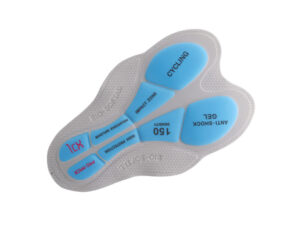Chamois play a pivotal role in the comfort and performance of cyclists. Originating as real leather made from goat or chamois skin, modern chamois are crafted from advanced synthetic materials designed to reduce friction and manage moisture. These crucial pieces of cycling apparel are engineered to prevent the chafing and bruising that can occur from long periods in the saddle. Proper care of your chamois not only enhances its functional lifespan but also ensures it continues to provide the necessary comfort on your rides. This article delves into the vital do’s and don’ts of chamois care, guiding you on how to preserve the quality and effectiveness of your cycling gear.
1. Selecting the Right Chamois
Choosing the right chamois is not just about comfort, it’s about your performance and enjoyment on the bike. The right chamois acts as a protective barrier, reducing the risk of skin irritation and discomfort. Whether you’re a long-distance cyclist or a weekend warrior, this knowledge empowers you to make informed choices that enhance your riding experience.
Factors to Consider in Chamois Selection
When choosing a chamois, consider the type of cycling you participate in. Road cyclists, for instance, may require thinner, denser padding to avoid excessive bulk and allow for greater freedom of movement, while mountain bikers might benefit from thicker, more robust padding for better shock absorption. Climate is another important factor; riders in hotter climates should look for chamois with superior moisture-wicking properties to prevent sweat buildup and reduce skin irritation.
Material and Padding Varieties
Today’s market offers a variety of chamois materials, each with unique benefits. Foam padding is widely favored for its ability to conform to the body’s shape, providing personalized comfort. Gel padding, however, is prized for its shock-absorbing qualities, making it ideal for rough terrains and long-duration rides. Understanding the differences between these materials will help you make an informed choice tailored to your specific cycling needs.
2. Essential Do’s for Chamois Maintenance
Maintaining your chamois is crucial for ensuring it performs well and lasts through many cycling sessions. Proper maintenance not only helps in preserving the materials of the chamois but also in maintaining its protective qualities.
Proper Washing Techniques
Always wash your chamois after each use to remove buildup of sweat and bacteria, which can degrade the material and lead to skin irritation. It’s recommended to wash your chamois in cool to warm water with a gentle, enzyme-free detergent, and avoid any additives like fabric softeners or bleach, which can break down the material fibers and padding. Hand washing is preferred, though a machine wash on a gentle cycle can be used for convenience.
Appropriate Drying Methods
After washing, air drying your chamois is the safest method to preserve its shape and material integrity. Hang your chamois in a cool, shaded area as direct sunlight can degrade the fabric and elastic. Avoid the use of a tumble dryer, as the heat can shrink and harden the padding, reducing its effectiveness.
3. Critical Don’ts for Chamois Care
Knowing what not to do is as important as knowing the correct care procedures to avoid inadvertently shortening the lifespan of your chamois.
Avoiding Common Mistakes
Never iron or dry clean your chamois, as high temperatures can damage the padding and elastic fibers. Additionally, avoid leaving your chamois wet or bundled up after use, as this can promote bacterial growth and odor, and can also cause the material to deteriorate more quickly.
Substances to Steer Clear From
Be wary of using any lubricants or creams that are petroleum-based with your chamois. These substances can degrade synthetic fabrics and affect the moisture-wicking properties of the chamois. Instead, opt for water-based products specifically designed for use with cycling chamois.
This section completes the first three headings of the article, providing a thorough understanding of how to select, maintain, and care for your chamois to ensure it provides maximum comfort and durability.
4. Storage and Handling of Chamois
Proper storage and handling of your chamois are key to preserving its functional qualities and extending its lifespan. Correct practices prevent damage and ensure that your chamois remains in good condition, ready for your next ride.
Correct Folding and Storage
Store your chamois in a dry, cool place away from direct sunlight, which can degrade the materials over time. Fold your chamois loosely or roll it to avoid creases that might damage the padding. Ensure the storage area is clean and free from dust and moisture, which can foster the growth of mold and mildew.
Handling Tips to Avoid Damage
Handling your chamois with care is crucial. After washing, gently squeeze out excess water—do not wring it out, as this can distort the padding and elastic. When your chamois is not in use, avoid stacking heavy items on top of it, which can compress and permanently alter the structure of the padding.
5. Enhancing Chamois Comfort and Fit
Ensuring your chamois is comfortable and fits well not only improves your riding experience but can also prevent injuries and discomfort during long rides. Here are ways to enhance the comfort and fit of your chamois.
Adjustments for Optimal Comfort
Occasionally, adjustments to your chamois or cycling shorts might be necessary to ensure optimal comfort. This might include ensuring that the chamois is properly aligned and positioned in your cycling shorts. A misaligned chamois can lead to chafing and discomfort, which can detract from your cycling performance and enjoyment.
Customizing Fit for Your Body
Everyone’s body is unique, and sometimes, off-the-shelf chamois might not provide the perfect fit. Consider visiting a specialty cycling shop where professionals can tailor the fit of your chamois or cycling shorts. This can be particularly beneficial for cyclists who ride frequently or for long durations, as even minor discomfort can become significant over time.
6. When to Replace Your Chamois
Knowing when to replace your chamois can help you maintain comfort and avoid potential issues from worn-out gear. Regular inspection and timely replacement ensure that your rides are always safe and comfortable.
Signs of Wear and Tear
Look for signs of wear, such as thinning of the padding, tears or holes in the fabric, and a general breakdown of the material. These signs indicate that the chamois is no longer providing the intended level of protection and comfort.
The lifespan of Different Chamois Materials
The lifespan of a chamois varies depending on its material composition and how well it is cared for. A good rule of thumb is to consider replacing your chamois after about 7,000 to 10,000 miles of use, or if you notice any of the above signs of wear. Higher quality materials may last longer, but they also require consistent and proper care.
These sections of the article continue to build on the theme of proper chamois care by emphasizing the importance of storage, handling, comfort adjustments, and recognizing when it’s time for a replacement. This information is crucial for any cyclist looking to maintain their gear in top condition.
7. Expert Tips for Chamois Longevity
Maintaining the longevity of your chamois not only saves you money but also ensures consistent comfort and performance on your rides. Here are expert tips and insights from cycling professionals on how to extend the life of your chamois.
Insights from Cycling Professionals
Many professional cyclists suggest having multiple chamois pads and rotating their use. This practice reduces the wear and tear on any single chamois, helping to extend their overall lifespan. Additionally, professionals often recommend paying close attention to the cleaning agents used; opting for gentle, non-biological detergents can prevent the breakdown of the materials.
Top Recommendations and Practices
To further enhance chamois longevity, consider using specialized chamois creams. These creams are designed to reduce friction and moisture, which can degrade the chamois material over time. Applying these creams before rides can help protect the fabric and padding, especially on longer journeys.
8. FAQ on Chamois Care
Addressing the most common questions and concerns about chamois care can help cyclists of all levels maintain their gear effectively. Here are answers to some frequently asked questions:
Can I use regular detergent to wash my chamois?
It is best to use a mild, enzyme-free detergent specifically designed for sports apparel to prevent damage to the chamois fabric and padding.
How often should I replace my chamois?
The frequency of replacement depends on the amount of use, but a general guideline is to replace your chamois every 7,000 to 10,000 miles or if you notice signs of wear, such as thinning padding or tears.
Is it necessary to use chamois cream?
While not strictly necessary, chamois cream can significantly enhance comfort and reduce the risk of chafing and saddle sores, especially on longer rides. It also helps protect the integrity of the chamois material.
9. Conclusion and Final Thoughts
Taking proper care of your chamois is essential for ensuring a comfortable and enjoyable cycling experience. By following the do’s and don’ts outlined in this article, you can extend the life of your chamois and enhance your overall cycling performance. Remember to regularly inspect your chamois for signs of wear, clean it properly after each use, and store it correctly to maintain its shape and functionality. With the right care, your chamois can provide lasting comfort and protection on all your cycling adventures.
10. 10 Tips for Chamois Care
- Wash After Every Use: Always clean your chamois after each ride to remove sweat and bacteria.
- Use Gentle Detergent: Select mild, enzyme-free detergents that are safe for technical fabrics.
- Air Dry Properly: Hang your chamois to dry in a cool, shaded place; avoid direct sunlight and heat sources.
- Rotate Your Chamois: Use multiple chamois and rotate them to even out wear and tear.
- Check for Damage: Regularly inspect your chamois for signs of wear and replace it when necessary.
- Apply Chamois Cream: Use chamois cream to reduce friction and protect the material.
- Store Correctly: Keep your chamois in a dry, flat position to avoid folds and creases.
- Avoid Harsh Chemicals: Steer clear of bleach and fabric softeners that can degrade the fabric.
- Follow Manufacturer’s Instructions: Always adhere to the care instructions provided by the manufacturer.
- Consider Professional Fitting: Get your chamois professionally fitted to ensure optimal comfort and performance.
These tips and practices are designed to guide both novice and seasoned cyclists in maintaining their chamois effectively, ensuring that each cycling experience is as comfortable as possible.





